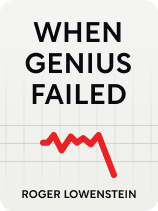

This article is an excerpt from the Shortform book guide to "When Genius Failed" by Roger Lowenstein. Shortform has the world's best summaries and analyses of books you should be reading.
Like this article? Sign up for a free trial here.
Why did the hedge fund LTCM fail so horribly? What can you learn from LTCM’s failure?
In When Genius Failed, Roger Lowenstein explores the spectacular rise and catastrophic 1998 collapse of the hedge fund Long-Term Capital Management (LTCM). He explores the history of LTCM, how its models operated, and how its success turned into a failure.
Read below for a brief overview of When Genius Failed.
When Genius Failed by Roger Lowenstein
In When Genius Failed, Roger Lowenstein explores how LTCM, initially hailed as a financial genius, used complex mathematical models and sophisticated trading strategies to generate massive profits. The fund’s founders and managers believed that they’d discovered a way to eliminate or at least greatly minimize market risk through their strategies. Their overconfidence in their models ultimately led them to make highly leveraged—i.e., debt-financed—bets on various financial instruments.
The fund engaged in a variety of strategies involving arbitrage (taking advantage of price differences for the same asset or security in different markets to make a profit with little to no risk), interest rate swaps, and other derivative instruments to exploit supposed market mispricings. However, when the market was beset by volatility following the Asian financial crisis of 1997, LTCM’s positions rapidly deteriorated—leading to the fund’s demise and an orchestrated bailout by the Federal Reserve.
Part 1: The Rise of John Meriwether and the Birth of Quantitative Trading
Lowenstein writes that hedge fund manager and arbitrage expert John Meriwether was pivotal in the conception and formation of LTCM. In this section, we’ll look at Meriwether’s early career as a trader at Merrill Lynch, where he discovered the power of arbitrage strategies and convergence theory, and his formation of the arbitrage group at the investment firm Salomon Brothers. These activities set the stage for what he’d later do to great effect at LTCM.
The Power of Arbitrage
Lowenstein writes that, at Salomon Brothers, Meriwether began his journey by learning the intricate art of arbitrage, a strategy that would become the linchpin of his success. Meriwether’s arbitrage strategy at Salomon Brothers enabled him to exploit price discrepancies, turning them into substantial profits.
At its core, notes Lowenstein, Meriwether’s strategy was rooted in the concept of convergence. He believed that differences in price between nearly identical financial securities would eventually equalize. By structuring his trades to bet on these convergences, he consistently emerged richer at Salomon Brothers, far more often than he faced losses.
Pioneering the Arbitrage Group at Salomon Brothers
By the early 1980s, writes Lowenstein, Meriwether had assembled a team of academic quants—individuals from academia who could introduce intellectual rigor and computer-based mathematical modeling into trading, moving away from the instinct-driven approach. His team at Salomon Brothers built computer models that identified market inefficiencies. They could pinpoint instances where bond prices deviated from what they “should” be in a perfectly rational market. These discrepancies presented unprecedented opportunities to buy below market value or sell above market value.
Part 2: The Birth of LTCM
Shortly after Meriwether left Salomon Brothers, he sought to create a new fund. In this section, we delve into the emergence of Long-Term Capital Management (LTCM); LTCM’s unique convergence strategy; and the high-risk, high-reward nature of its approach.
Meriwether’s Vision: Long-Term Capital Management
Lowenstein writes that John Meriwether envisioned striking out on his own by applying the convergence strategy that had brought him success at Salomon Brothers. This marked the intellectual underpinning of what became LTCM.
The core strategy was simple: Buy assets identified as underpriced by their model while simultaneously shorting similar assets deemed overpriced. The premise was that the prices of these assets would eventually converge. In essence, LTCM aimed to “buy low and sell high” at the same time they were “selling high and buying low.”.
Launching the Fund
To start his new fund, notes Lowenstein, Meriwether recruited a team of top-notch academic economists and central bankers, including Robert Merton, Myron Scholes (who would later win a Nobel Prize in economic sciences), and David Mullins.
Armed with his dream team, Meriwether and his fundraisers embarked on a roadshow, dazzling investors and successfully raising $1.25 billion in capital. They secured investments from European and Japanese banks, prominent American CEOs, and elite private universities.
Lowenstein writes that many of these key investors were wowed by the intellectual brilliance of the LTCM partners and the track record they had at other firms. Investors saw LTCM as low-risk since it was run by a team of ex-Salomon Brothers traders who had reached the pinnacle of financial success there—and they assumed the team could replicate that success. Crucially however, notes Lowenstein, most of these investors had little understanding of how LTCM’s complex trading strategy actually worked: They put their faith in the all-star partners roster and their sterling reputations.
With funding in place, Long-Term Capital Management commenced trading in February 1994, marking the start of an ambitious venture that would have a significant impact on the financial world.
Leverage: Amplifying the Strategy
Lowenstein writes that what set LTCM’s approach apart was its use of substantial leverage, i.e., borrowed funds, to increase its volume of trades. Since price differences between the bonds they traded were marginal, the profits per trade were minimal. To generate substantial profits, LTCM needed to execute trades at high frequencies and volumes, which required a significant reserve of capital. And they could only acquire those reserves through borrowing. The strategy was an inherently “high risk-high reward” one for LTCM: If their model succeeded, profits could be magnified manifold times through leverage. However, if the model failed, losses would also be greatly amplified due to the debt incurred.
However, banks were willing to provide loans generously due to the perceived prestige of LTCM. Despite LTCM’s lack of transparency and secretive internal culture, the banks competed for the opportunity to lend to LTCM, seeing the new hedge fund as a potentially valuable client. Accordingly, the banks were willing to lend on highly favorable terms—even if they had a difficult time understanding exactly what LTCM was doing.
Part 3: LTCM’s Stunning Initial Success
With the foundation thus laid, it was time for LTCM to put its strategy into action. In this section, we’ll explore the extraordinary rise of LTCM and the growing risks posed by its high leverage—which ultimately set the stage for its downfall.
Implementing the Strategy
Lowenstein writes that LTCM boasted an astounding 28% return in its first year of operation in 1994, significantly outperforming the broader market. Their approach was grounded in quantitative and mathematical methods, giving an impression of rationality and scientific precision.
LTCM’s success was predicated on its ability to find arbitrage opportunities and capitalize on mispricing across various financial assets, from mortgage-backed securities to international bonds.
A Mistaken Assumption of Predictability
According to Lowenstein, LTCM’s model was built on the assumption that financial markets behave predictably. The crux of the problem, writes Lowenstein, lay in that core assumption of the world’s rationality and predictability. In reality, the real world is complex, shaped by irrational human behavior, and events are often influenced by panic and fear, making human actions less predictable.
Lowenstein writes that research by Eugene Fama highlighted the higher risk of extreme or “tail” events in markets, contrary to LTCM’s belief in constant predictability. Markets, in fact, exhibited more extreme price movements than would be expected from a normal distribution curve. The likelihood of an extreme financial event (say, a sudden, across-the-board collapse in asset prices) was far more likely than their models predicted. In a few short years, such outlier events would prove fatal to LTCM.
Continued Profits and Growth
Despite these philosophical flaws, writes Lowenstein, LTCM continued to amass impressive profits, earning 59% or $1.6 billion in 1995. Wall Street bankers were eager to lend more money to the fund, given its outstanding performance. LTCM had become the darling of Wall Street, outgrowing even the largest mutual funds. By 1996, the partners had collectively earned nine times their initial investment, a staggering return on investment. In that year alone, LTCM’s profits exceeded $2 billion, surpassing those of major Fortune 500 companies and even Wall Street giants like Meriwether’s old firm, Salomon Brothers.
However, its rapid growth was precarious: For every $1 in assets, the fund had $28 in debts. LTCM kept banks in the dark about the fund’s total degree of leverage, and they refused to disclose the assets on their balance sheet. Banks had to rely on LTCM’s supposed genius and financial acumen, which masked the true riskiness of the investments they were unknowingly bankrolling.
Part 4: The Fall of LTCM
The year 1997 was the beginning of the end for LTCM, as it succumbed to the enormous risks it had taken on and the combined pressures of the 1997 Asian financial crisis and the 1998 Russian financial crisis. In this section, we’ll explore how unexpected volatility began to sink the fund.
1997: The Asian Financial Crisis Begins
In 1997, the currencies of several Asian countries—Indonesia, Malaysia, the Philippines, South Korea, and Thailand, the so-called “Asian tigers”—collapsed. In the years leading up to the crisis, investors had mistakenly believed that the economies of these nations were on sounder footing than they actually were. As a result, when these currencies collapsed, those investors found that their money was now tied up with these sharply devalued currencies. The crisis spread to the US as the American stock market suffered a 7% decline in a brutal selloff on October 27, 1997.
The crisis threatened to undermine LTCM’s whole strategy. In a turbulent market, asset prices tend to fall together: There aren’t price discrepancies, writes Lowenstein, because everything collapses at the same time. There wouldn’t be arbitrage opportunities to exploit: There would instead be a liquidity crisis where everyone was trying to sell their much-discounted assets at the same time, LTCM included. This had the potential to wipe out the fund.
The Russian Collapse and the Flight to Treasurys
The collapse of the Russian ruble in August and September 1998 exacerbated the impending liquidity crisis in global financial markets, intensifying the fund’s difficulties. Russia defaulted on its financial obligations, sending shockwaves throughout global financial markets. This triggered widespread panic as investors sought refuge in US Treasury securities.
For LTCM, this situation led to a noticeable difference in prices between US Treasury bonds and other financial products. This difference influenced a broad array of assets, including common ones like stocks and foreign bonds, as well as more complicated financial tools like options, derivatives, and swaps. People rushed to invest in Treasurys, which are seen as safe because they’re backed by the US federal government. This surge in demand caused the prices of Treasurys to go up while the prices of everything else went down.
On the Wrong Side of the Trades
Compounding LTCM’s woes was the fact that their existing positions were based on the expectation of the opposite scenario. Their entire strategy was built on the belief that markets overstated risk and that the price differences between risky assets and safe assets would eventually converge. Consequently, they often held the riskiest and most volatile assets in various markets. When universal panic gripped the market in 1998 following the Russian crisis, nobody had any interest in purchasing LTCM’s holdings, and everyone was eager to rid themselves of these toxic assets. LTCM found itself in a dire predicament, with seemingly no way out.
With the value of their assets now reduced to a fraction of their former worth, their debts constituted an even larger portion of their balance sheet. By September, LTCM was operating with a highly leveraged position of $55 in leverage for every $1 in assets and the fund was hemorrhaging eight figures per day.
The Panic Market Trumps the Rational Market
Lowenstein writes that the market was characterized by panic, representing a state of irrationality. Human emotions, including greed and fear, were driving economic decisions, highlighting the flawed and irrational nature of such decisions. The market deviated from a normal distribution pattern. LTCM’s quantitative models were incapable of accounting for this irrationality, as they were built upon a framework assuming rational and utility-maximizing decisions.
An Orchestrated Bailout
As the house of cards that was LTCM collapsed, the New York Federal Reserve Bank stepped in to orchestrate a bailout. According to Lowenstein, the Fed played a pivotal role in assembling a consortium of Wall Street banks to stabilize and wind down the troubled LTCM. The final terms of the rescue package involved a consortium of over a dozen major banks collectively contributing more than $3.5 billion and acquiring 90% of whatever value remained in the fund. In a stark transformation, the original partners retained only a 10% stake as an incentive for their assistance in winding down the fund and ensuring creditors were made whole.
The partners found themselves effectively wiped out, and the banks were left to recoup whatever assets remained. The impact extended beyond the fund; it significantly affected the partners themselves, many of whom had substantial personal wealth tied up in the fund. The collapse pushed several of them into personal bankruptcy.
A Tale of Hubris
Lowenstein writes that the LTCM episode served as a stark reminder that even the brightest minds in finance were not immune to failure. In a period of soaring returns on Wall Street during the 1990s, LTCM’s renowned academics and financial wizards were among the few who managed to lose money. By the end of the crisis, the fund’s assets were worth a mere 23% of their peak value.The bailout of LTCM raised legitimate concerns about moral hazard, as it prompted questions about whether rescuing reckless speculators only encouraged future speculative behavior. It also led to a broader debate about whether preventive regulation to avert a financial crisis might be a superior approach to the post-crisis bailouts.

———End of Preview———
Like what you just read? Read the rest of the world's best book summary and analysis of Roger Lowenstein's "When Genius Failed" at Shortform.
Here's what you'll find in our full When Genius Failed summary:
- The 1998 collapse of Long-Term Capital Management (LTCM)
- The history of LTCM, how it operated, and how it achieved success
- Insights to the LTCM story in light of subsequent events






